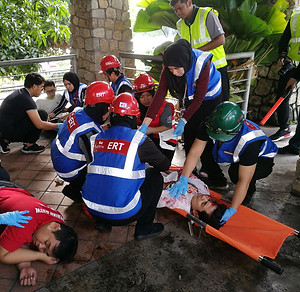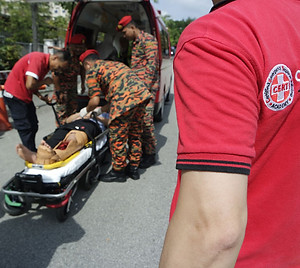Emergency Response Team Training (ERT)
Accredited by:
American Heart Association, DOSH / JKKP, National Fire Protection Association (NFPA)
Program Description:
Participants to become a Certified Emergency Response Team (CERT) member and able to handle various type of emergencies and disasters. The training cover Basic Life Support Skill such as CPR, Choking, introduction of defibrillator (AED); rescuing technique and skill such as transporting patient, patient assessment / diagnosis of the patient; first aid treatment; airway management; splinting; dressing and bandaging and etc.
To add on the value of Emergency Response Team member, we had include the module of fire fighting and emergency response and preparedness program so that the ERT members is equipped with fire drill on how to put off small fire effectively and how to handle a major disaster which require them to activate Incident Command system. In this module, they will learn types of fire, types of fire extinguisher, and communication systems during disaster and evacuation procedure.
Module Outline:
Day One (1): Basic Occupational First Aid, CPR & AED Certification Program
Introduction to the course
-
Ice Breaking
-
Rules of Games
About Death
-
Clinical death and brain death.
-
Common Causes of Sudden Death: Heart Attack, Cardiac Arrest.
-
Introduction for Chain of survival.
Basic Life Support (2015 ECSI and AHA Guidelines) Comparison between 2015 & previous CPR guideline;
-
Emergency action principle
-
Concept of CPR
Cardiopulmonary Resuscitation (CPR) for adult, child and infant;
-
Recovery position
Practical – Basic Life Support
-
CPR for adult, child and infant
-
Speed & Depth of chest compression
-
When to stop CPR
-
Recovery position & purpose
Automated External Defibrillator (AED)
-
AED operation
-
AED application
-
Special considerations
Practical - Automated External Defibrillator (AED)
Foreign Body Airway Obstruction (Choking)- Heimlich Maneuver
-
Sign and symptom of airway obstruction
-
Choking management for adult, children and infant
-
Special consideration – obesity and pregnant
Shock
-
Causes of shock
-
The progression of shock
-
Care for shock
Bleeding and Wounds
-
Care of wounds
-
Amputations
-
Impaled objects
-
Gunshot wounds
-
Closed wounds
-
Penetrating wound
-
Disease precautions
Practical – Dressings and Bandaging
Day Two (2): Basic Occupational First Aid, CPR & AED
Skill Assessment for:
-
Basic life support
-
Recovery position
-
Airway obstruction
Introduction To First Aid Kit (DOSH Guideline)
-
DOSD requirement
-
Function of each item
Burns and Scalds
-
Degree of Burn
-
Management of burns & scalds
-
Chemical Burn
Practical – Rescuing & Moving
-
Shoulder Drag
-
Ankle Drag
-
Human Crutch
-
Cradle Carry
-
Piggyback Carry
-
Firefighter Carry
-
Extremity Carry
-
Two Handed Seat Carry
Practical - Bone, Muscle and Extremity Injuries
-
Bone injury (fractures)
-
D.O.T.S
-
Sprains & Strains
-
RICE
-
Types of splints
-
Splinting guidelines
-
Slings
-
Splinting specific areas
Practical - Spinal Injuries & Patient Transportation
-
Spinal injuries
-
Recognizing spinal injuries
- Care for spinal injuries
- Immobilizing the head and spine
-
Log roll
-
Helmet removal
-
Applying collar
Patient Assessment
-
Scene size-up
-
Primary and secondary survey
-
Medical History
Mock-drill and Skill Assessment
-
Scenario based learning (complicated emergency situations)
-
Role play and team work
-
The strength and weakness on oneself
-
Post mortems and de-briefing
Written Assessment – Multiple Choice Questions
Evaluation and Closing
Day Three (3): Basic Fire Fighting Training
Fire Protection
-
The Need For Fire Training
Fire Drills
Causes of Fire
-
At Work, Home, Natural Disaster, Arson and Unknown
Chemistry of Fire
-
Element of Fire
-
Heat Transfer
Classification of Fire
-
Class A, B, C & D
Method of Extinguishing Fire
-
Smothering
-
Cooling
-
Starvation
-
Chain Reaction
Portable Fire Extinguishers :
Types of Extinguisher and Usage
-
CO2
-
Water
-
Dry Powder
-
Foam
Selection of Fire Extinguisher
-
Red, Blue, Black and Cream
Principles of Fire Extinguisher
Basic Steps in Operating Fire Extinguisher
-
PASS Technique
Technique of Fire Fighting
-
Different Technique of Fighting Fire
-
Safety Precaution in Extinguishing Fire
Detection System
-
General Detection System Available
-
Smoke, Heat and Flame
-
Basic Operation
Sprinkler System
-
Basic Principles of Sprinkler System
-
Basic Operation
Hose Reel System
-
Basic Principle
-
Handling Operation
Action In The Event of Fire
-
FIRE Technique
Self Rescue Technique
-
Method of Self Rescue
-
Risk Assessment
-
Safety Precaution
Fire Fighting Team
-
Function of Fire Team
-
Fire Team Organization
Duties and Responsibilities of Fire Fighting Team
Practical Session
-
Controlled Fire using portable extinguisher and hose reel. Hands on practice by participants
Day Four (4): Emergency Response Plan & Preparedness
-
Emergency Response Identification
-
Scope of Emergency Plan
-
Major hazards at workplace
-
Developing Emergency Plans
-
Emergency Communication
-
Understanding Company Emergency Response Plan
-
Shutdown and Evacuation Procedures
-
Emergency Facilities and Exercises
-
Incident Command Control
-
Designing Drills and Exercises
-
Case study and Evacuation Drill
Duration:
4 Days
Prerequisite:
None
Training Method:
Classroom, Instructor-Led-Hands-on-Practical Training, Mockup Drill.
Assessment Methods:
Practical
What is the core competency do I get by earning this certificate?
Participant will able to handle any emergency situation that occurs. They will able to help victims until proper help from hosp or firefighter come to the rescue.
What will I able to do as a result earning this certificate?
Participant can enroll to Emergency Respond Team at their workplace. Most of employee will give extra credit or maybe allowance to their staff that contribute as ERT member.
How will earning this certificate benefits me and my employer?
Participant will become competent in ERT. They will able to save lives in emergency situation. For employer, their workplace will become safer.
Max Class Capacity:
20-30 persons.
Suitable For:
Public, Student, Worker that work in mid - high risk environment.
Career Pathway:
Fire & Life Safety Manager, First Aid Team
Course Date:
To be advice (TBA) - Please contact us.



